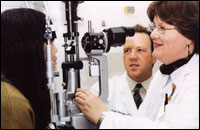Types of Glaucoma
There are several types of glaucoma, including primary, secondary, childhood and normal-tension.
Glaucoma is an eye disease in which the pressure inside the eye rises to a point that it damages the optic nerve and impairs vision. There are many types of glaucoma, although there are two main, or primary, forms.
Primary types of glaucoma
 There are two primary types of glaucoma:
There are two primary types of glaucoma:
- Open-angle glaucoma: Out of all of the types of glaucoma, this is the most common form. In open-angle glaucoma, the pressure inside the eye increases slowly and destroys vision gradually, starting with side vision. Most people who develop open-angle glaucoma notice no symptoms until vision is impaired.
- Acute angle closure glaucoma: This is a rare, yet serious glaucoma type, in which pressure inside the eye rises suddenly and must be lowered quickly to prevent permanent vision loss. This is an eye emergency because optic nerve damage and significant vision loss can occur within hours of the onset. Symptoms can include blurred vision, eye pain, headache, halos around lights, nausea and vomiting. If you have any of these symptoms, please call your ophthalmologist immediately. Rarely, there may be no symptoms.
Secondary glaucoma types
In addition to the two primary types of glaucoma, there are a number of secondary glaucomas, all of which have an identifiable secondary cause for the increased eye pressure. These types of glaucoma include:
- Neovascular glaucoma: A rare glaucoma type that occurs in diabetics and as the result of other vascular diseases of the eye. In neovascular glaucoma, blood vessels grow across the normal outflow channels of fluid in the eye. It is difficult to treat and the patient often needs to be seen by a retinal specialist in collaboration with a glaucoma specialist.
- Traumatic glaucoma: This type of glaucoma is caused by an injury to the eye and may develop immediately after an injury to the eye or years later. It can be caused by injuries that “bruise” the eye (called blunt trauma) and injuries that penetrate the eye. Conditions that increase the risk of a serious eye injury include severe nearsightedness, previous trauma and prior eye surgery.
Childhood glaucomas
In rare cases, glaucoma also can affect children. Juvenile glaucoma starts in childhood and may have a stronger hereditary component. This is a difficult type of glaucoma to treat and usually requires a multidisciplinary approach, including collaboration between a glaucoma specialist and pediatric ophthalmologist. Congenital glaucoma is another juvenile glaucoma type that appears soon after birth or within the first year of life. However, unlike other childhood glaucomas, congenital glaucoma often has noticeable signs, including:
- Tearing
- Light sensitivity
- Cloudiness of the cornea
Normal-tension glaucoma
With this glaucoma type – also known as low-tension or normal-pressure glaucoma – the optic nerve is damaged even though intraocular pressure (IOP) is within a normal range. Even with this form of glaucoma, lowering IOP is important.
At Henry Ford, patients come first.
The Henry Ford Department of Ophthalmology is committed to providing our patients with compassionate, personalized care. We feature the most advanced treatments in eye care and are dedicated to vision research – always staying at the forefront of innovation. A leader in Michigan, as well as one of the largest ophthalmology practices in the United States, we treat more than 55,000 patients per year at 12 locations throughout southeast Michigan. In addition, our team works closely with Henry Ford Medical Group physicians in other departments, providing multidisciplinary, coordinated care for those patients who need it.
.svg?iar=0&hash=F6049510E33E4E6D8196C26CCC0A64A4)

/hfh-logo-main--white.svg?iar=0&hash=ED491CBFADFB7670FAE94559C98D7798)